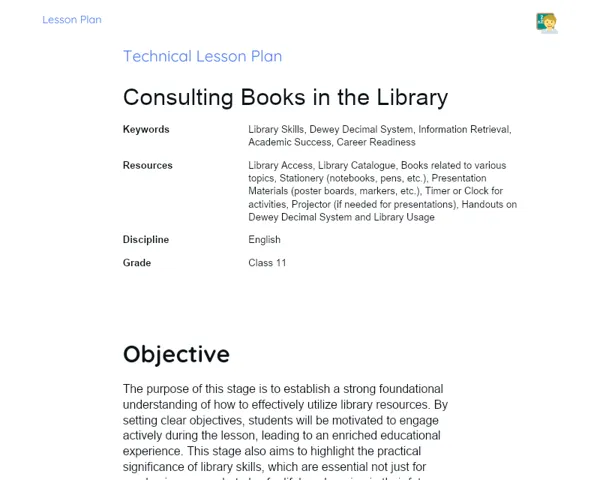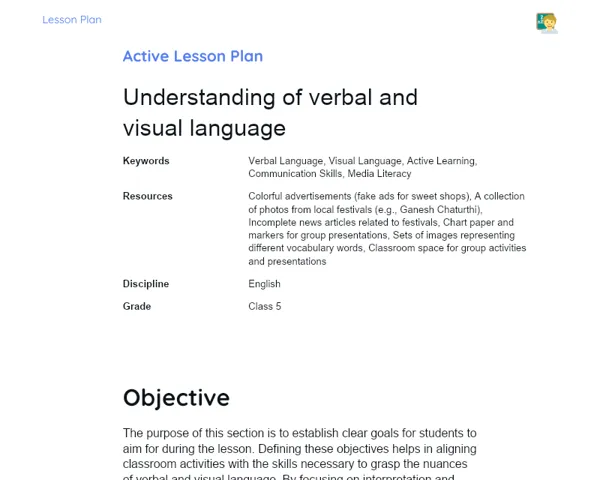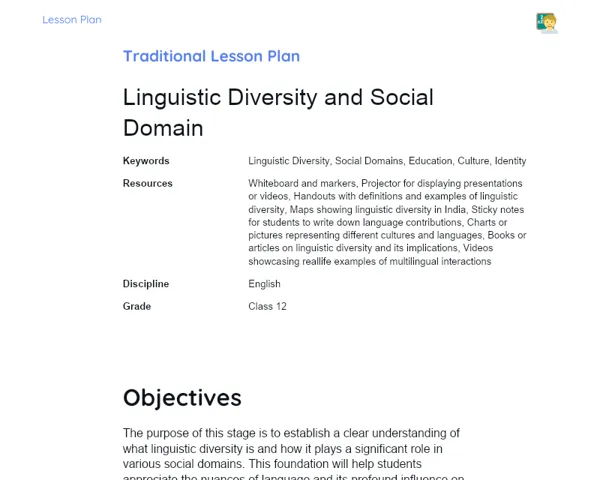Lesson Plan | Socioemotional Learning | Analysis of Meaningful Proverbs
| Keywords | Proverbs, Emotional Intelligence, RULER Method, Self-Awareness, Self-Management, Responsible Decision-Making, Social Skills, Social Awareness, Cultural Wisdom, Personal Reflection |
| Resources | List of meaningful proverbs relevant to Indian culture, Whiteboard and markers, Notebooks and pens for students, Materials for group presentations (e.g. props, paper for posters), Timer for activity management, Comfortable seating arrangement for group work, Printed handouts with the RULER method summary, Reflection prompts for written reflection activity |
| Codes | - |
| Grade | Class 8 |
| Discipline | English |
Objectives
Duration: (5 - 10 minutes)
The purpose of this step in the Socioemotional Lesson Plan is to set clear, focused, and relatable objectives that align with both the emotional and cognitive development of the students. By establishing these objectives, students can better understand what they are aiming to achieve during the analysis of proverbs, fostering a connection between their personal experiences and the lessons drawn from these traditional sayings. This helps in nurturing self-awareness and social awareness as they reflect on their own feelings and the feelings of others while engaging with the material.
Main Objectives
1. To enable students to identify and understand the emotional significance behind different proverbs.
2. To encourage students to explore personal connections with selected proverbs and articulate their meanings in context.
Introduction
Duration: (15 - 20 minutes)
Emotional Warmup Activity
Breathe and Focus
Guided Deep Breathing
1. Instruct students to sit comfortably in their chairs with their feet flat on the floor and hands resting on their knees.
2. Ask them to close their eyes gently or lower their gaze to minimize distractions.
3. Guide them to take a deep breath in through their nose for a count of four, holding it for a count of four.
4. Encourage students to exhale slowly through their mouth for a count of six, letting go of any tension.
5. Repeat this process for five cycles, reminding them to focus solely on their breath and how their body feels with each inhalation and exhalation.
6. After the fifth cycle, gently ask them to open their eyes and bring their attention back to the room.
Content Contextualization
Proverbs are not just words strung together; they carry the wisdom of generations, reflecting collective experiences and emotions. In India, we often say, 'A stitch in time saves nine,' which highlights the importance of timely action. Similarly, analyzing proverbs allows students to connect these timeless sayings to their personal lives, sparking self-reflection and emotional intelligence. For instance, when students hear the proverb 'An ounce of prevention is worth a pound of cure,' they might recall a time when they neglected their studies, which later affected their results. Such reflections nurture responsible decision-making and self-awareness while underscoring the importance of learning from the past.
Development
Duration: (60 - 75 minutes)
Theory Guide
Duration: (20 - 25 minutes)
1. Explain that proverbs are short, commonly known sayings that express a truth or advice based on common sense or experience. They often reflect cultural values and present wisdom in a concise and memorable way.
2. Discuss the origin of proverbs, noting that many have been passed down through generations and can vary in meaning across different cultures. For example, the Indian proverb 'A bird in the hand is worth two in the bush' teaches the value of appreciating what one already has rather than risking it for more.
3. Introduce the concept of analyzing proverbs to uncover emotional connections. Explain how proverbs can illustrate feelings and emotions related to experiences, such as regret, happiness, or determination. An example could be 'Don't count your chickens before they hatch,' which cautions against assuming future success based on present circumstances.
4. Introduce the RULER method in context with proverbs: students can recognize emotions evoked by the meaning of a proverb, understand the circumstances that led to the proverb's creation, label their feelings, express these feelings in discussions, and regulate their responses in conversations about personal experiences related to proverbs.
5. Encourage personal reflection by asking students to think of a situation in their life where a proverb applied. This exercise can help them articulate their feelings and understand their responses in similar situations, thus enhancing self-awareness and responsible decision-making.
Activity with Socioemotional Feedback
Duration: (30 - 35 minutes)
Proverb Storytelling Circle
In this engaging group activity, students will work in small groups to select a proverb, discuss its meaning, personal significance, and share a story related to it. Each group will create a short presentation or role-play to express their understanding of the proverb and its emotional undertones, fostering both social skills and emotional intelligence.
1. Divide the class into small groups of 4-5 students.
2. Assign or let each group choose a different proverb from a provided list of meaningful proverbs relevant to Indian culture, such as 'The pen is mightier than the sword' or 'Where there’s a will, there’s a way.'
3. Instruct groups to discuss the meaning of their chosen proverb, its emotional significance, and any personal experiences that relate to it.
4. Encourage groups to create either a short skit or a presentation that reflects their understanding and connection to the proverb.
5. Each group will share their presentation with the class, allowing time for questions and feedback after each presentation.
Discussion and Group Feedback
After each group presentation, engage the class in a discussion using the RULER method. Begin by helping students recognize their own emotions and the emotions expressed by their peers during the presentations. Ask questions like, 'How did this story make you feel?' or 'What emotions do you think were captured by the proverb?'. Encourage students to understand the causes of these feelings by discussing how the proverb's message resonates in their own lives. Next, guide them to label these emotions, using terms like happiness, nostalgia, or caution. Finally, facilitate a conversation about how they can express these emotions appropriately in different contexts. This flood of discussion will help them regulate their emotions and cultivate a deeper understanding of both proverbs and the emotional undercurrents they embody.
Conclusion
Duration: (10 - 15 minutes)
Reflection and Emotional Regulation
At the end of the lesson, guide students in a reflection session to discuss the challenges they faced while analysing proverbs and managing their emotions. Encourage them to think about how they expressed their feelings during group activities and share insights on situations that might have elicited strong emotional responses. This can be done through a written reflection or an open class discussion where students can comfortably share their thoughts.
Objective: The objective of this reflection activity is to foster self-assessment and emotional regulation by helping students identify effective strategies for managing their emotions in challenging situations. By articulating their experiences and feelings, students cultivate self-awareness and self-management skills, ensuring they can handle similar situations in the future with greater emotional intelligence.
Glimpse into the Future
Conclude the lesson by encouraging students to set personal and academic goals aligned with the concepts learned about proverbs. Ask them to write down at least one goal related to their emotional growth, such as improving their ability to recognize and express emotions, and one academic goal, such as applying proverbs in writing or presentations. This activity can solidify their understanding of the lesson's content and its relevance in their daily lives.
Setting Goals:
1. Recognize and express emotions more effectively in group settings.
2. Connect proverbs with personal experiences in future discussions.
3. Apply the learnings from proverbs to academic assignments.
4. Cultivate resilience by reflecting on emotional responses during challenges. Objective: The objective of this ending activity is to promote student autonomy and facilitate the practical application of the lessons learned during the analysis of proverbs. By setting personal and academic goals, students take ownership of their learning and emotional development, paving the way for continuous growth both in their studies and personal lives.



